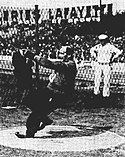Lekkoatletyka na Letnich Igrzyskach Olimpijskich 1936 – rzut młotem mężczyzn
Rzut młotem mężczyzn był jedną z konkurencji rozgrywanych podczas XI Letnich Igrzysk Olimpijskich. Został rozegrany 3 sierpnia 1936 roku na Stadionie Olimpijskim w Berlinie. Wystartowało 27 zawodników z 16 krajów.
Rekordy
| Zawodnik | Wynik | Miejsce | Data | |
|---|---|---|---|---|
| Rekord świata | 57,77 | 17 sierpnia 1913(dts)[1] | ||
| Rekord olimpijski | 54,74 | 14 lipca 1912(dts)[2] |
Terminarz
| Data | Godzina | |
|---|---|---|
| 3 sierpnia 1936 | Kwalifikacje | 9:00 |
| Finał | 15:00 |
Wyniki
Kwalifikacje
Minimum kwalifikacyjne do finału wynosiło 46,00 m. Indywidualne wyniki zawodników nie są znane.
| Pozycja | Zawodnik | Państwo | Wynik | Uwagi |
|---|---|---|---|---|
| Isao Abe | Q | |||
| Koit Annamaa | ||||
| Anton Barticevic | ||||
| Erwin Blask | ||||
| Giovanni Cantagalli | ||||
| Henry Dreyer | ||||
| Donald Favor | ||||
| Bernhard Greulich | ||||
| Karl Hein | ||||
| Sulo Heino | ||||
| Gunnar Jansson | ||||
| Gustaf Koutonen | ||||
| Evert Linné | ||||
| Ville Pörhölä | ||||
| William Rowe | ||||
| Fred Warngård | ||||
| Joseph Wirtz | ||||
| Christos Dimitropulos | ||||
| Norman Drake | ||||
| Jaroslav Eliáš | ||||
| Pedro Goić | ||||
| Hans Houtzager | ||||
| Emil Janausch | ||||
| Jaroslav Knotek | ||||
| Eiichiro Matsuno | ||||
| Assis Naban | ||||
| Milan Stepišnik |
Finał
| Poz. | Zawodnik | Reprezentacja | Próby | Wynik | Uwagi | |||||
|---|---|---|---|---|---|---|---|---|---|---|
| 1 | 2 | 3 | 4 | 5 | 6 | |||||
| 1. | Karl Hein | 52,13 | 52,44 | x | 54,70 | 54,85 | 56,49 | 56,49 | ||
| 2. | Erwin Blask | 52,55 | 55,04 | x | 54,10 | 54,48 | x | 55,04 | ||
| 3. | Fred Warngård | 52,05 | 52,98 | 54,03 | 54,83 | 53,30 | 50,61 | 54,83 | ||
| 4. | Gustaf Koutonen | x | 50,01 | 51,90 | 49,11 | 49,91 | x | 51,90 | ||
| 5. | William Rowe | 51,53 | 51,04 | 49,29 | 50,32 | 51,66 | x | 51,66 | ||
| 6. | Donald Favor | 50,78 | 50,02 | 51,01 | 48,48 | 50,33 | 47,71 | 51,01 | ||
| 7. | Bernhard Greulich | 50,19 | x | 50,61 | – | – | – | 50,61 | ||
| 8. | Koit Annamaa | 48,77 | 49,54 | 50,46 | – | – | – | 50,46 | ||
| 9. | Henry Dreyer | 49,81 | x | 50,42 | – | – | – | 50,42 | ||
| 10. | Sulo Heino | 49,93 | 47,15 | 48,30 | – | – | – | 49,93 | ||
| 11. | Ville Pörhölä | 45,35 | x | 49,89 | – | – | – | 49,89 | ||
| 12. | Gunnar Jansson | 49,21 | 48,49 | 49,28 | – | – | – | 49,28 | ||
| 13. | Isao Abe | 47,40 | 41,83 | 49,01 | – | – | – | 49,01 | ||
| 14. | Evert Linné | x | 47,25 | 47,61 | – | – | – | 47,61 | ||
| 15. | Giovanni Cantagalli | 45,21 | 47,42 | 45,08 | – | – | – | 47,42 | ||
| 16. | Joseph Wirtz | x | 44,82 | 45,69 | – | – | – | 45,69 | ||
| 17. | Anton Barticevic | x | 43,02 | 45,23 | – | – | – | 45,23 | ||
Przypisy
- ↑ Progression of IAAF World Records. 2015 Edition, IAAF, s. 198 [dostęp 2022-03-19] (ang.).
- ↑ 1912 Summer Games Olympics, Athletics, Hammer Throw, Men, olympedia.org [dostęp 2022-03-19] (ang.).
- ↑ Janusz Waśko, John Brant, Györgyi Csiki, Andrzej Socha: Golden Century of IAAF Records. National Records Evolution 1912-2012. Zamość: 2013, s. 151. ISBN 978-83-62033-30-0. (ang.)
- ↑ Janusz Waśko, John Brant, Györgyi Csiki, Andrzej Socha: Golden Century of IAAF Records. National Records Evolution 1912-2012. Zamość: 2013, s. 156. ISBN 978-83-62033-30-0. (ang.)
Bibliografia
- Olympic Official Reports Collection – XI Olympic Games, Berlin, 1936 : Official Report, v.2, s. 680–682 [dostęp 2022-03-19] (ang.).
- 1936 Summer Olympics. Athletics. Hammer Throw, Men, olympedia.org [dostęp 2022-03-19] (ang.).
Media użyte na tej stronie
Olympic Rings without "rims" (gaps between the rings), As used, eg. in the logos of the 2008 and 2016 Olympics. The colour scheme applied here pertains to the 2016 Olympics in Rio de Janeiro.
Olympic Rings without "rims" (gaps between the rings), As used, eg. in the logos of the 2008 and 2016 Olympics. The colour scheme applied here pertains to the 2016 Olympics in Rio de Janeiro.
An icon that represents a gold medal
An icon that represents a silver medal
An icon that represents a bronze medal
US Flag with 48 stars. In use for 47 years from July 4, 1912, to July 3, 1959.
Łatwo można dodać ramkę naokoło tej grafiki
Autor: F l a n k e r, Licencja: CC BY-SA 2.5
Łatwo można dodać ramkę naokoło tej grafiki
Flaga Finlandii
Sport records icon to be used for national records.
Pictograms of Olympic sports – . This is an unofficial sample picture. Images of official Olympic pictograms for 1948 Summer Olympics and all Summer Olympics since 1964 can be found in corresponding Official Reports.
Erwin Blask, vice-champion d'Europe du lancement du marteau en 1938.
1936 Press Photo Karl Hein for hammer throw in the Olympics - net19986
Fred Warngård
Sport records icon to be used for Olympic records.
























